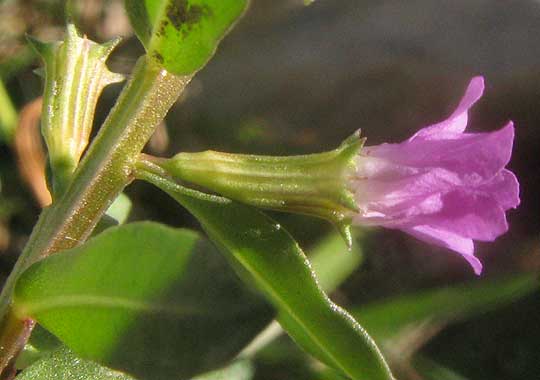Excerpts from Jim Conrad's
Naturalist Newsletter

from the November 10, 2013 Newsletter issued from the Frio Canyon Nature Education Center in the valley of the Dry Frio River in northern Uvalde County, southwestern Texas, on the southern border of the Edwards Plateau; elevation ~1750m (~5750 ft); N29.62°, W99.86°; USA
LOW LOOSESTRIFE
In mud where water trickled from a spot near the water's edge on a gravel bar in the Dry Frio River -- which still is so low that sometimes in completely disappears beneath the gravel -- an ankle-high herb showed up with tiny lavender-hued flowers. It was in a precarious place, where cattle come to drink the pool's water, and where, if we were to get a good rain, the whole gravel bar would disappear below rushing water. Despite its fragile appearance, it was definitely an opportunistic and tough little plant. That's it above.
A close-up of its 3/8ths-inch-long (9mm) flower with a strikingly ribbed, slender calyx arising singly from a squared stem is shown below:

Below, you see a blossom with petals removed on one side to reveal a spherical, yellow stigma held above the calyx by a slender, white style extending from the ovary deep in the calyx's cup.

The most interesting feature to notice in that picture is that each petal arises from a spot on the calyx rim, between the calyx teeth. It's unusual for petals to arise in such a manner, and that cued me to this wildflower's family, which is the small, mostly tropical American Loosestrife Family, the Lythraceae. Checking to see what Loosestrife Family species occur in this area, it was easy enough to figure out that we had a Low Loosestrife, LYTHRUM OVALIFOLIUM. A second, more commonly occurring loosestrife occurs in our area, Lythrum californicum, but that species' leaves are narrower than ours.
Low Loosestrife is described as rare along and in water of rivers and streams of the eastern Edwards Plateau region of central Texas, and nowhere else. It's endemic just to here.
Some loosestrife species are much larger and bear spectacular inflorescences of purplish flowers, and thus are well known and appreciated wildflowers. Our little Low Loosestrife is clearly adapted to a very narrow habitat, one in which lushness and gaudiness aren't helpful.
The history of the name loosestrife is a good one. Back in the 1500s someone came up with the name loosestrife when they mistranslated the Latin name Lysimachia, which was used for a group of plants similar to our Lythrum. They mistranslated the name because they thought the Latin name Lysimachia was Greek, not Latin, and in Greek the word lusimakhos meant "ending strife." Lysimachia plants actually were named for Lysimachus, a king of ancient Sicily, who is said to have calmed a mad ox by feeding it a member of the genus. Anyway, not only is Lysimachia Latin and not Greek, thus having nothing to do with ending strife, but also Lysimachia plants don't even belong to the same family as our loosestrifes of the genus Lythrum.